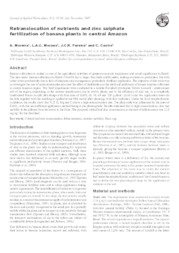Retranslocation of nutrients and zinc sulphate fertilization of banana plants in central Amazon.
Retranslocation of nutrients and zinc sulphate fertilization of banana plants in central Amazon.
Author(s): MOREIRA, A.; MORAES, L. A. C.; PEREIRA, J. C. R.; CASTRO, C.
Summary: Banana cultivation is ranked as one of the agricultural activities of greatest economic importance and social significance in Brazil. The area under banana cultivation in Brazil (516,000 ha) is larger than India and Ecuador, leading countires in production, but with rather lower productivity due to lack of adequate crop management, particularly fertilizer application. The objective of this work was to investigate the rate of nutrient retranslocation and the effect of fertilization on the yield and uniformity of banana bunches cultivated in central Amazon region. Two field experiments were conducted in a xanthic Ferralsol (dystrophic Yellow Latosol) - predominant soil of the region, examining: a) the nutrient translocation rate in twelve plants; and b) the efficiency of zinc use, in a completely randomized blocks in split plot design with four rates of ZnSO4 (0, 30, 60 and 120 g plant-1 cycle-1) and two application times (in the hole together with the seedling or applied in the fifth month after planting), with four replicates. Under the local edaphoclimatic conditions, the results show that N, P, K, Mg and Cu have a high retranslocation rate. The plant yield was influenced by the rates of ZnSO 4, with the most efficient application method being in the planting hole. Results indicated that at high concentrations, zinc had mobility in the phloem from the leaves to the fruits. The proposed critical leaf zinc concentration at the start of inflorescence was 12.9 mg kg-1 for the third leaf.
Publication year: 2007
Types of publication: Journal article
Observation
Some of Embrapa's publications are published as ePub files. To read them, use or download one of the following free software options to your computer or mobile device. Android: Google Play Books; IOS: iBooks; Windows and Linux: Calibre.
Access other publications
Access the Agricultural Research Database (BDPA) to consult Embrapa's full library collection and records.
Visit Embrapa Bookstore to purchase books and other publications sold by Embrapa.

